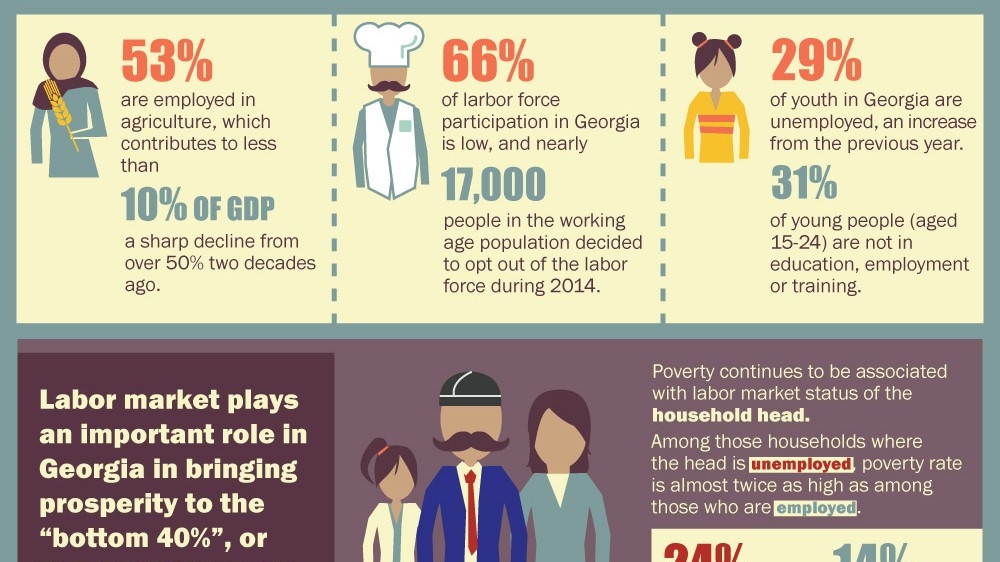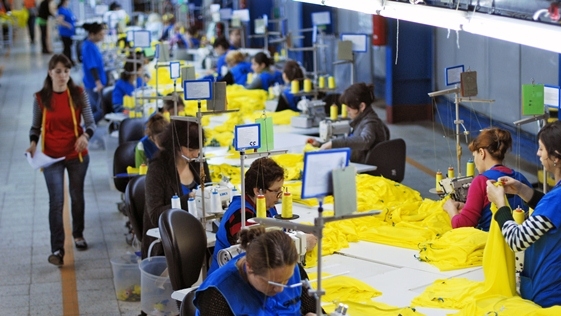Economic Restructuring
Analysis from a World Bank report, Back to Work: Growing with Jobs in Europe and Central Asia, shows that net job creation in a country generally reflects its pace of economic restructuring. Georgia had just reached a state of balanced job flows when the 2008 global financial crisis struck. With intensive enterprise reforms carried out relatively later than other countries across the Europe and Central Asia region, job destruction and labor shedding in older sectors of Georgia’s economy were proportionally offset by job creation in the new sectors.
Over the past two decades, Georgia’s agriculture sector has continued to employ roughly half the labor force, but the sector’s contribution to GDP over that same period has declined from nearly 50 percent to less than 10 percent.
Entrepreneurship
Compared with the region’s advanced economic reformers, Georgia has had a mixed record of entrepreneurship. Although the country has a relatively good business environment, the pool of latent entrepreneurs is relatively small, and the share of small and medium-sized enterprises (SMEs) per 1,000 people is also relatively low in comparison to other countries in the region. Compared with their counterparts in the neighboring countries, Georgian entrepreneurs are less likely to engage in radical innovations that were new to the market.
Skilled Labor Force
While job creation calls for sustained market reforms and takes time to materialize, skills are at the core of improving an individual’s labor market outcome. Lack of adequate skills for gainful employment, as well as for innovative entrepreneurship, has signaled a range of weaknesses in the country’s education and training systems.
Georgian students generally do not compare well with students in other countries in international student assessments. In addition, the World Bank Skills for Employment and Productivity (STEP) household survey recently found that essential “behavior skills” have an important effect on one’s labor market outcome in Georgia. Furthermore, the STEP employer survey confirmed that a large number of firms perceive a lack of adequately skilled workers to be a major bottleneck for business expansion.
Incentives to Work
Low labor force participation has necessitated further examination of the roles of labor market institutions and social benefits in providing incentives or disincentives for work. Having gone through a deregulation phase, Georgia’s labor market today remains largely flexible.
With regard to social benefits, a recent study has found that Georgia’s targeted social assistance (TSA) program does not have work disincentives for men. However, on average, a woman who receives TSA is 7 to 11 percentage points less likely to be active in the labor market.
Ease of migration for work is also an important factor for improved labor market outcomes. Georgians overall remain relatively unwilling to migrate for work, which indicates a need to explore the barriers that they may face in this regard.
The Way Forward for the South Caucasus
Labor is the most important asset of the poor. In a survey of all three South Caucasus countries – Georgia, Armenia and Azerbaijan – citizens and policy makers alike identified jobs as one of the top development priorities.
The challenges to job creation are inherently multi-sectoral and complex, and shaped by the specific political economy aspects of each country. Although a wealth of sector-specific diagnostics exists that can contribute to our understanding of these challenges, there are still significant knowledge gaps – we need to know much more about compositions and trends in both creation and destruction of jobs.
We need to understand the key determinants of labor reallocation and mobility across employment categories and sectors, and ways to raise productivity within employment categories and sectors. Job expansion is not just about expanding wage work or the formal sector; a key challenge is how to raise the productivity of self-employment, agriculture, and informal enterprises. A collaborative effort is essential, therefore, in order to move forward the integrated jobs agenda for more and better jobs in the South Caucasus.
This is the third story in a three-part series about the jobs challenge in the South Caucasus. See also:
The Jobs Challenge in the South Caucasus – Armenia
The Jobs Challenge in the South Caucasus – Azerbaijan


